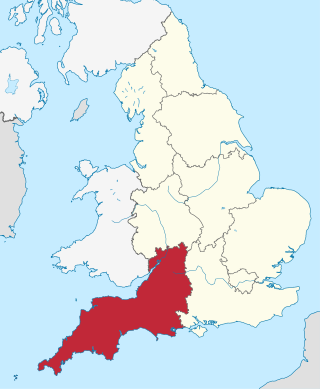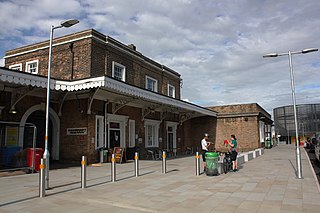
South West England, or the South West of England, is one of nine official regions of England. It consists of the counties of Bristol, Cornwall, Dorset, Devon, Gloucestershire, Somerset and Wiltshire. Cities and large towns in the region include Bath, Bristol, Bournemouth, Cheltenham, Exeter, Gloucester, Plymouth and Swindon. It is geographically the largest of the nine regions of England covering 9,200 square miles (23,800 km2), but the third-least populous, with approximately five million residents.

The West Somerset Railway (WSR) is a 22.75-mile (36.6 km) heritage railway line in Somerset, England. The freehold of the line and stations is owned by Somerset County Council; the railway is leased to and operated by West Somerset Railway plc ; which is supported and minority-owned by charitable trust the West Somerset Railway Association (WSRA) and the West Somerset Steam Railway Trust (WSSRT). The WSR plc operates services using both heritage steam and diesel trains.

The Avon Valley Railway (AVR) is a three-mile-long heritage railway based at Bitton station in South Gloucestershire, England, between Bristol and Bath and is operated by a local group: The Avon Valley Railway Company Ltd. The railway follows the Avon Valley south-east from Oldland Common, through Bitton and alongside the River Avon towards Kelston and Bath. The railway shares its route with the Sustrans cycleway and footpath, the Bristol and Bath Railway Path.

The Somerset and Dorset Joint Railway, also known as the S&D, SDJR or S&DJR, was an English railway line connecting Bath and Bournemouth, with a branch from Evercreech Junction to Burnham-on-Sea and Bridgwater. Strictly speaking, the main line ran from Bath Junction to Broadstone, as the line between Broadstone and Bournemouth was owned by the London and South Western Railway, while the line between Bath Junction and Bath was owned by the Midland Railway.

Taunton railway station is a junction station on the route from London to Penzance, 143 miles (230 km) west of London Paddington station. It is situated in Taunton, Somerset, and is operated by Great Western Railway. The station is also served by CrossCountry trains and by the West Somerset Railway on special event days and by mainline steam excursions.
The Bristol and Gloucester Railway was a railway company opened in 1844 to run services between Bristol and Gloucester. It was built on the 7 ftBrunel gauge, but it was acquired in 1845 by the 4 ft 8+1⁄2 instandard gauge Midland Railway, which also acquired the Birmingham and Gloucester Railway at the same time.

Bridgwater railway station serves Bridgwater in Somerset, England. It is on the Bristol to Taunton Line and is operated by Great Western Railway. It is 151 miles 47 chains from the zero point at London Paddington via Box.

The Bristol & Exeter Railway (B&ER) was an English railway company formed to connect Bristol and Exeter. It was built on the broad gauge and its engineer was Isambard Kingdom Brunel. It opened in stages between 1841 and 1844. It was allied with the Great Western Railway (GWR), which built its main line between London and Bristol, and in time formed part of a through route between London and Cornwall.

Washford railway station is a station on the West Somerset Railway, a heritage railway in England. The station is situated in the village of Washford, which is itself within the civil parish of Old Cleeve in the county of Somerset.

Bishops Lydeard railway station is a heritage railway station in the village of Bishops Lydeard, Somerset, England. It is the southern terminus for regular trains on the West Somerset Railway.

Norton Fitzwarren railway station is an untimetabled station on the West Somerset Railway in Somerset, England. It was built in 2009 about 1⁄4 mile (0.4 km) north of the site of the old station that served the village of Norton Fitzwarren from 1873 until 1961. There were fatal railway accidents in the vicinity in 1890, 1940 and 1978.

Mangotsfield railway station was a railway station on the Midland Railway route between Bristol and Birmingham, 5.1 miles (8.2 km) north-east of Bristol Temple Meads and 82 miles (132 km) from Birmingham New Street, serving what is now the Bristol suburb of Mangotsfield. The station was opened in 1845 by the Bristol and Gloucester Railway, but had very little in the way of passenger amenities. The station was resited in 1869 to serve the new Mangotsfield and Bath Branch Line, and became an important junction station with extensive facilities and six platforms. Passenger footfall however failed to match the station's size, though at its peak eight staff were employed. The station closed in 1966 when services to Bath ended as part of the Beeching cuts, and the line through the station closed in 1969. The railway became a cycle path in the 1980s, and is a popular resting point on the route as several of the station's walls and platforms are still in situ.
The Bristol and North Somerset Railway was a railway line in the West of England that connected Bristol with Radstock, through Pensford and further into northern Somerset, to allow access to the Somerset Coalfield. The line ran almost due south from Bristol and was 16 miles (26 km) long.

The earliest known infrastructure for transport in Somerset is a series of wooden trackways laid across the Somerset Levels, an area of low-lying marshy ground. To the west of this district lies the Bristol Channel, while the other boundaries of the county of Somerset are along chains of hills that were once exploited for their mineral deposits. These natural features have all influenced the evolution of the transport network. Roads and railways either followed the hills, or needed causeways to cross the Levels. Harbours were developed, rivers improved, and linked to sources of traffic by canals. Railways were constructed throughout the area, influenced by the needs of the city of Bristol, which lies just to the north of Somerset, and to link the ports of the far south-west with the rest of England.

The Bristol to Exeter line is a major branch of the Great Western Main Line in the West of England and runs from Bristol, to Exeter, from where it continues as the Exeter to Plymouth line. It was one of the principal routes of the pre-1948 Great Western Railway which were subsequently taken over by the Western Region of British Railways and are now part of the Network Rail system.
The Bristol and Gloucestershire Railway was an early mineral railway, opened in two stages in 1832 and 1834, which connected collieries near Coalpit Heath with Bristol, at the river Avon. Horse traction was used. It was later taken over by the Bristol and Gloucester Railway, and much of the route became part of the main line between Birmingham and Bristol, though that was later by-passed and closed. Part of it now forms the Bristol and Bath Railway Path.












